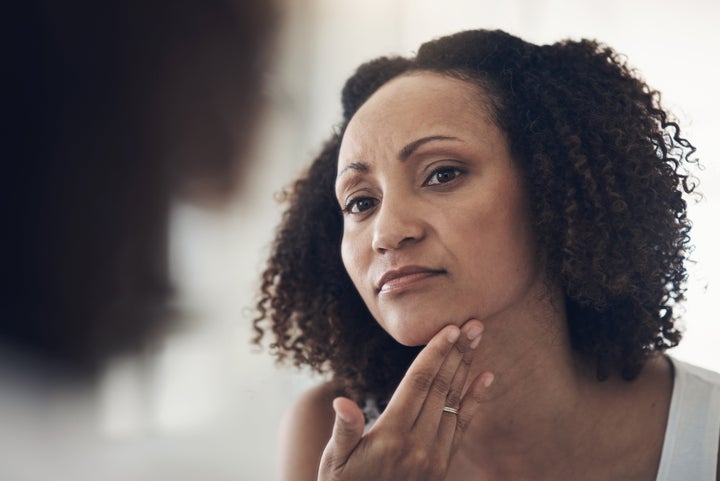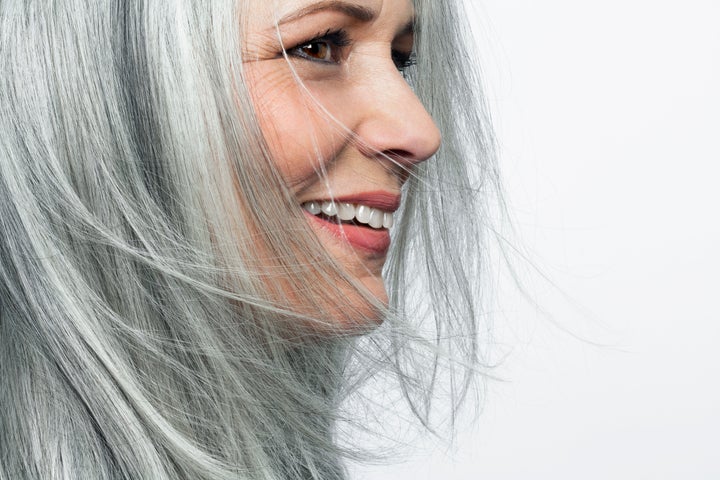A couple of years ago, while on a bike-packing trip through Armenia and Georgia, my friend Amy and I walked through the streets of Tbilisi. We were both 49 years old at the time, and I told her about how, over the last year, I felt as if I had become more emotional and more easily angered than I used to be and I didn’t know why.
“Ummm, perimenopause?” she said, laughing. The thought had never crossed my mind. I don’t know why perimenopause and menopause aren’t talked about more, why this huge transition in a woman’s life seems to be such a “secret” subject in polite society. Once I figured out that I was indeed in the midst of perimenopause (and I still am two years later), so many things began to make sense. I think I’ve experienced every possible symptom of perimenopause, including hot flashes, trouble sleeping, brain fog, forgetfulness, anxiety and heavier period bleeding than usual. And then there are the skin issues.
I’ve never in my life had any kind of acne, but over the past couple of years, a lone pimple would pop up every month or so. The skin on my elbows was drier than it ever used to be. And small hairs from my Eastern European heritage would show up more consistently on my chin.
I talked to some medical experts to understand some of what was going on.
What happens during perimenopause
Dr. Mary Jane Minkin, clinical professor in the Department of Obstetrics, Gynecology, and Reproductive Sciences at the Yale University School of Medicine and a board-certified obstetrician and gynaecologist, first told me that I’d be all right. I’d make it through this transition, even if sometimes I felt as if I were going crazy. Then she explained that the cause of most of my issues was sporadic, fluctuating hormone levels.
“The way I describe it to my medical students,” Minkin said, “is that if you were to draw a picture of what hormone levels do during perimenopause, they would look like the Dow Jones industrial average in September of 2008: It went very far down but it wasn’t smooth; it was jaggedy.”

As Minkin outlined for me, during a normal Jane Doe menstrual cycle, oestrogen and progesterone levels vary significantly, but usually in a regular, cyclical way. A ballpark baseline level for oestrogen at the beginning of a woman’s period is 40 to 50 picograms (pg) per milliliter. A week or so before the start of the period, levels go up to a high of 300 or 350 pg per milliliter. During ovulation, the area the egg comes out of makes progesterone as well. Post-menopause, oestrogen levels go below 20 pg per milliliter and stay that way while the ovaries cease making progesterone.
“And then,” Minkin said, “there’s perimenopause. That’s the tricky area, because what happens is things go really crazy.” What she meant by this is that oestrogen and progesterone levels no longer go up and down in a regular way. They are sporadic, sometimes spiking, then dropping more quickly than during a normal cycle. And this causes all sorts of havoc in our bodies (and emotions).
What perimenopause does to your skin
As far as skin-related issues go, testosterone is predominantly to blame. Our ovaries, besides making oestrogen and progesterone, also make testosterone. On average, the ovaries stop making oestrogen at 51 years old, while testosterone production can go on until about the age of 60. “Your oestrogen levels are declining, but you’re still chugging out a good amount of testosterone,” Minkin told me.
And the unwanted hair? Testosterone is to blame for that, too. “As your oestrogen is reduced, testosterone becomes more prominent and may cause unwanted hair growth,” said Dr. Laura Carinci, clinical assistant professor in the Department of Obstetrics and Gynecology at NYU Langone Health.
It’s androgens (a group of hormones responsible for “traditional” masculine traits and reproductivity) that cause unwanted hair. “Some people in general have hair follicles that are more sensitive to male hormones, which anti-androgen therapy can help with,” Carinci explained.
Oestrogen, on the other hand, is responsible for helping to keep collagen in our skin. When oestrogen levels go down, so does collagen production, which can exacerbate wrinkles or dry skin.
How to treat skin issues associated with perimenopause
So what can we do to treat skin issues related to perimenopause? Minkin encouraged women to talk to their doctor about the possibility of oestrogen therapy. “A lot of my patients take oestrogen because of skin issues,” she said, “because they don’t like having skin dryness and loss of elasticity, and oestrogen does help.”
“The biggest thing in terms of preventing and helping yourself with skin changes really is skin protection, wearing sunblock that blocks both UVA and UVB rays, such as products with zinc and titanium oxide,” Carinci said.

If you’re experiencing a lot of skin issues during perimenopause, you may also want to take a look at the products you’re using.
“There are a lot of hormonal shifts that are taking place in your body and it’s not linear. Your levels can go up and down unexpectedly,” said Dr. Rajani Katta, a dermatologist at the Baylor College of Medicine and McGovern Medical School at University of Texas Houston. “You may need to change the kinds of skin care products you’re using.”
Katta recommended switching to heavier creams or ointments for moisturising in lieu of lotions, which have a high water content. “As soon as you get out of the shower, while your skin is still damp, apply a cream on top to lock that moisture into the skin,” she said.
According to Katta, the most common places for hormonal acne are the chin and jawline. While teenagers tend to get blackheads and white lumps, women who are dealing with hormonal acne usually get those red pimples that come from under the surface.
“Most importantly, you want to make sure all your skin care products are non-comedogenic,” Katta said. Non-comedogenic means the product is formulated specially to not block the skin’s pores. Katta explained that over-the-counter acne spot treatments with ingredients such as benzoyl peroxide or salicylic acid formulated in a cream base do dry up pimples and are likely more suited for hormonal acne, because they are not quite as intense and drying (to the skin) as prescription treatments. The reason for this is that most prescribed acne medicine has a gel base — and may even contain alcohol — which is more drying.
“For people who are experiencing fine lines and wrinkles in some areas on their face, we do recommend medicated products with a vitamin A derivative and retinoids, because those can help build up collagen,” Katta said. Just remember, though, that balance is always key.
“I’ve seen people start to go with anti-aging skin care products that just irritate the heck out of their skin. So it’s really important to find that right balance between something that will help you without irritating you,” she cautioned.
“It’s a phase and it will get better. It gets better. I find many of my patients in menopause really feel good once they’re there. Maybe because it’s a different stage of life, but many feel a sense of freedom and I think it can be a really great stage of life. I think you should look forward to it,” Carinci said.
I, for one, am definitely looking forward to it.